Chapter One Hundred Seventeen
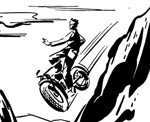 Richard Talmadge--Stuntman Richard Talmadge--Stuntman
by Boyd Magers
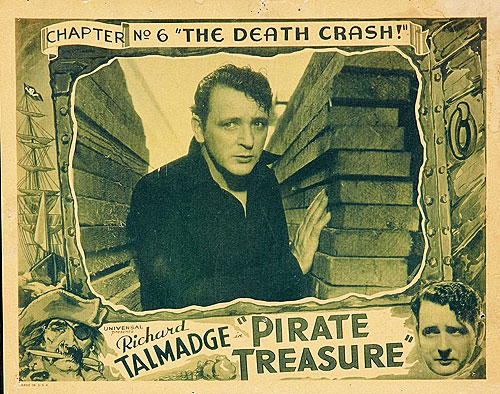
In the early years of motion pictures, stuntmen—or daredevils as they were often then known—performed some of the most death defying stunts ever created. Certainly a case can be made for Richard Talmadge as being the greatest stuntman/daredevil of all time.
Born Sylvester Alphonse Metzetti in Camburg, Germany on December 3, 1892, he first came to the U.S. as a boy member of the Metzetti Five Troupe of acrobats engaged by the Barnum and Bailey Circus circa 1913.
With a name change to Richard “Dick” Talmadge his first ever movie stunt—or “gag”—as it’s often referred to, was a leap from the top of a four-story building for the silent serial “The Million Dollar Mystery” filmed at Ft. Lee, NJ in 1914. For that job he was paid $20, but by the time he paid the guys he’d hired to hold a net for him to land in, his take home pay amounted to $4.
Dick and his brothers did a lot of work in one and two reel comedies throughout the teens, but Richard’s big break came in 1920 when he was hired as fight choreographer on “The Mark of Zorro” starring Douglas Fairbanks Sr. He continued to work with and double Fairbanks on several other silent epics. It was Fairbanks who encouraged Talmadge to star in his own films beginning in the late ‘20s. Even though as a stuntman he had few equals he lacked that on-screen charismatic something that makes one a star. His thick European accent contributed to lack of appeal. In many low-budget actioners into the early ‘30s talkies he remained a minor player.
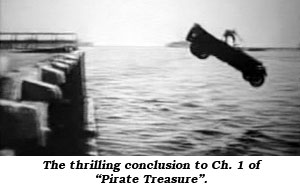 His one starring sound serial is a stunt-filled gem, “Pirate Treasure”, released in 1934 by Universal. The basic plot has Talmadge possessing a map to a buried pirate treasure on a tropical island with a gang of crooks (headed by Walter Miller) out to steal the map. The cliffhanger in Ch. 2 is one never to be forgotten or ever duplicated. Ken Weiss described it perfectly in his ‘05 book on jungle serials. “Dorothy (Lucille Lund) has been bound hand and foot, gagged and left in a room. She manages to work the gag free, then hops over to a window. Seeing Dick walking below, she smashes the window with her hip and draws his attention. He climbs up a drainpipe, hops into the room and frees Dorothy. Once she’s safe he tells her to wait 10 minutes then call the police. He climbs to the roof of the building and peers into a skylight. Below him is the gang poring over the stolen map. Talmadge opens the skylight window, leaps upon the group, grabs the map and exits via the skylight as the gang rush to the roof. Dick races over and around obstacles, jumping over some and sliding along wires while kicking, punching and tossing some of his pursuers off roofs and finally making a mighty, long-distance leap from one roof to another which discourages his pursuers, but not the two who are already on the other roof. Dick winds up being knocked from the roof and falling five stories, his fall being broken by five shade awnings which enable him to land unhurt on the ground.” His one starring sound serial is a stunt-filled gem, “Pirate Treasure”, released in 1934 by Universal. The basic plot has Talmadge possessing a map to a buried pirate treasure on a tropical island with a gang of crooks (headed by Walter Miller) out to steal the map. The cliffhanger in Ch. 2 is one never to be forgotten or ever duplicated. Ken Weiss described it perfectly in his ‘05 book on jungle serials. “Dorothy (Lucille Lund) has been bound hand and foot, gagged and left in a room. She manages to work the gag free, then hops over to a window. Seeing Dick walking below, she smashes the window with her hip and draws his attention. He climbs up a drainpipe, hops into the room and frees Dorothy. Once she’s safe he tells her to wait 10 minutes then call the police. He climbs to the roof of the building and peers into a skylight. Below him is the gang poring over the stolen map. Talmadge opens the skylight window, leaps upon the group, grabs the map and exits via the skylight as the gang rush to the roof. Dick races over and around obstacles, jumping over some and sliding along wires while kicking, punching and tossing some of his pursuers off roofs and finally making a mighty, long-distance leap from one roof to another which discourages his pursuers, but not the two who are already on the other roof. Dick winds up being knocked from the roof and falling five stories, his fall being broken by five shade awnings which enable him to land unhurt on the ground.”
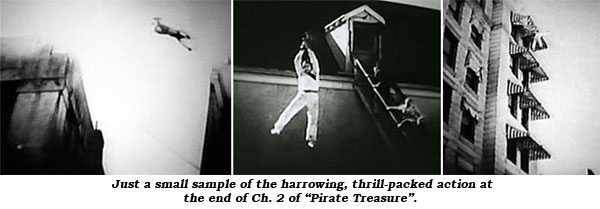
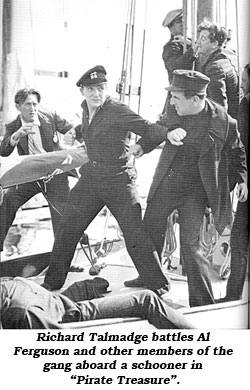 In his book BLOOD ‘N’ THUNDER’S CLIFFHANGER CLASSICS, Ed Hulse recognizes Talmadge’s contribution to making “Pirate Treasure” a thrill-packed serial. “A lot of this serial’s sparkle derives from the enthusiastic larger-than-life performance of leading man Richard Talmadge. He’s an ideal serial hero: chipper, bursting with energy, and ready to tear off after bad guys at a moment’s notice. He’s certainly not the world’s greatest actor, and he does possess a rather thick Swiss-German accent, but such points seem minor in view of the infectious enthusiasm of his performance. Then there’s all the spectacular stunt work he delivers throughout the serial. It’s hard to pick a highlight among the various acrobatic action scenes in “Treasure…” but a rooftop chase at the of Chapter 2, the later shipboard fight during a mutiny sequence and the car/motorcycle/train chase and fight sequence that spans Chapters 4 and 5 are among some of the best. Talmadge performs all these stunts himself, which supplies an added thrill for viewers.” In his book BLOOD ‘N’ THUNDER’S CLIFFHANGER CLASSICS, Ed Hulse recognizes Talmadge’s contribution to making “Pirate Treasure” a thrill-packed serial. “A lot of this serial’s sparkle derives from the enthusiastic larger-than-life performance of leading man Richard Talmadge. He’s an ideal serial hero: chipper, bursting with energy, and ready to tear off after bad guys at a moment’s notice. He’s certainly not the world’s greatest actor, and he does possess a rather thick Swiss-German accent, but such points seem minor in view of the infectious enthusiasm of his performance. Then there’s all the spectacular stunt work he delivers throughout the serial. It’s hard to pick a highlight among the various acrobatic action scenes in “Treasure…” but a rooftop chase at the of Chapter 2, the later shipboard fight during a mutiny sequence and the car/motorcycle/train chase and fight sequence that spans Chapters 4 and 5 are among some of the best. Talmadge performs all these stunts himself, which supplies an added thrill for viewers.”
Talmadge also appears as The Thunder Rider Captain in Mascot’s “Phantom Empire” in ’35 and performed countless stunts for Nat Levine’s Mascot serials—“Lone Defender” (‘30), “Lightning Warrior” (‘31), “Devil Horse” (‘32)—and at Universal—“Danger Island” (‘31), “Vanishing Shadow” (‘34).
Beginning in the mid ‘30s major studios began to hire him on a regular basis to perform death-defying stunts in such classics as “Trail of the Lonesome Pine”, “Spawn of the North”, “Beau Geste”, “The Desperadoes”, “Samson and Delilah”, “Prince Valiant”, “North to Alaska”, “How the West Was Won” and many more. As a result of his extraordinary ability to design, organize and execute some of the most difficult action sequences, Talmadge became one of the top second unit directors and assistant directors in the business on such films as “Trail of the Lonesome Pine”, “Beau Geste”, “From Hell to Texas”, “Flaming Star”, “How the West Was Won”, “Circus World”, “Greatest Story Ever Told”, “What’s New Pussycat”, “Casino Royale” and many more.
In the late ‘40s/early ‘50s Talmadge returned to his low budget roots, stunting/directing/acting in such fare as “Detour to Danger” (‘46), “Jeep Herders” (‘45) and “Border Outlaws” (‘50).
In 1979, at 87, Dick worked his final film as second unit director on “The Fantastic Seven”. In 1974 the film industry, along with Yakima Canutt and several other stunt luminaries, honored Talmadge at the Stuntman’s Association Dinner. Veteran serial
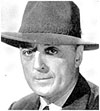 director Spencer Gordon Bennet (right), who began his own career as a stuntman, paid homage to Talmadge, “Dick was unique. For sheer guts no one topped him. Used his head, too. I’d say to him, Dick, I need you to do such-and-such-leap off a cliff, or whatever.’ And right away he’d dope out the angles, the trajectory, and how and where exactly he was going to land, things like that. Pretty soon, he’d call out—‘Ready when you are, Spence.’ Never had to ask him to do something twice, he’d get it right on the button the first take. He was a born show-off. Understand me, I don’t mean anything derogatory by that. Every stuntman, from the early silent days to the present was and is an entertainer at heart. And what’s an entertainer if he’s not a show-off? Sure, he’s in it for the money, but this thing that really motivates him is the unsatiable desire to entertain. The crazy side of it is, he does all his entertaining anonymously.”
director Spencer Gordon Bennet (right), who began his own career as a stuntman, paid homage to Talmadge, “Dick was unique. For sheer guts no one topped him. Used his head, too. I’d say to him, Dick, I need you to do such-and-such-leap off a cliff, or whatever.’ And right away he’d dope out the angles, the trajectory, and how and where exactly he was going to land, things like that. Pretty soon, he’d call out—‘Ready when you are, Spence.’ Never had to ask him to do something twice, he’d get it right on the button the first take. He was a born show-off. Understand me, I don’t mean anything derogatory by that. Every stuntman, from the early silent days to the present was and is an entertainer at heart. And what’s an entertainer if he’s not a show-off? Sure, he’s in it for the money, but this thing that really motivates him is the unsatiable desire to entertain. The crazy side of it is, he does all his entertaining anonymously.”
The grandfather of unsung stuntmen died of cancer January 25, 1981, at his home in Carmel, CA.
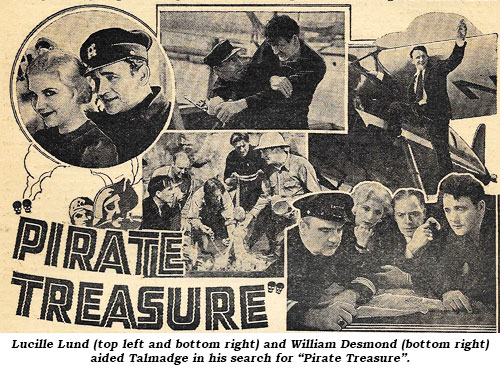

At the conclusion of Ch. 12 of “Mystery of the Riverboat” Robert Lowery’s busload of workers crashes directly into a power pole with electric flashes everywhere! But in Ch. 13, the bus does crash, but no electric flashes. |
top of page
| 
